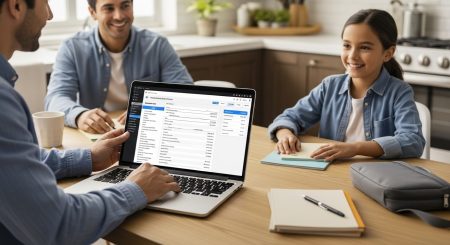Worried about saving for college without tax surprises? A 529 plan lets families grow money for education, tax deferred, then withdraw it tax free when used the right way.
The catch is simple: follow 529 plan rules for withdrawal or risk taxes and a 10 percent penalty on earnings.
Quick refresher, a 529 plan is a tax-advantaged account for education costs. In 2025, qualified withdrawals cover tuition, books, required supplies, and housing for eligible schools.
K-12 tuition is still allowed, and there may be increases to those limits depending on federal changes and plan updates.
Here is a real example. Maria owns a neighborhood café and funds a 529 for her son. She pays the spring 2025 tuition, then requests a matching 2025 withdrawal, keeps receipts, and stays fully tax free.
Why this matters for founders and small business owners, timing and documentation protect your tax savings. Withdraw in the same calendar year as the expense.
Keep records for every qualified cost, tuition invoices, 1098-Ts, and housing agreements.
In this guide, you will learn what counts as a qualified expense in 2025, how to time withdrawals the right way, and what happens with non-qualified uses.
You will see updates on K-12 rules, how to handle scholarships, and simple steps to avoid penalties. You will also get a checklist and examples you can copy, so you can use your 529 with confidence.
Check out our article on 529 Plan Income Tax: A Guide for Founders to explore more about 529 plan.
What Are Qualified Expenses Under 529 Plan Rules for Withdrawal?

Using a 529 the right way keeps your withdrawals tax free. Here is what counts in 2025, how housing works, and where the limits apply so you do not trigger taxes or the 10 percent penalty on earnings.
Higher Education Costs That Qualify
For college and eligible postsecondary schools, the core list stays consistent in 2025. Keep the student enrolled at least half-time to unlock room and board benefits.
-
Tuition and mandatory fees: Covered for eligible colleges, universities, and trade schools
-
Books, supplies, and required equipment: Textbooks, lab gear, calculators, and course materials
-
Computers and software: Covered if required for enrollment or coursework. This includes a laptop, educational software, and internet service used by the student during school
-
Room and board: Allowed if the student is at least half-time. On-campus housing is covered up to the school’s billed amount. Off-campus housing is capped by the school’s published cost of attendance for room and board
Quick reference for housing limits:
| Housing situation | Maximum qualified amount |
|---|---|
| On-campus housing | Actual amount charged by the school |
| Off-campus housing | School’s cost of attendance allowance for room and board |
What does this look like in practice? If your student takes online classes and the school requires a computer, buying a $900 laptop with 529 funds is qualified.
If they rent an apartment off campus, your qualified withdrawal for rent and meals cannot exceed the school’s published allowance.
Common costs that are not qualified:
- Transportation and parking passes
- Insurance and medical expenses
- Sports or activity fees not required for enrollment
- Furniture or dorm decor
Tip: Match withdrawals to each expense in the same calendar year, keep receipts, and note the student’s enrollment status.
That alignment supports clean 529 plan rules for withdrawal.
K-12 and Other Education Expenses
K-12 private school tuition remains eligible in 2025, with a hard cap. Some non-college pathways also qualify if they meet federal standards.
- K–12 tuition limit for 2025: Up to $10,000 per year, per beneficiary, for tuition at public, private, or religious schools
- Update on limits: The cap increases to $20,000 per year starting January 1, 2026, based on current guidance
- Apprenticeships: Qualified if the program is registered with the Department of Labor. Covered costs include fees, books, supplies, and required equipment
- Student loans: Up to $10,000 lifetime per beneficiary can be used to repay qualified student loan principal and interest. This is a lifetime cap, not an annual one
- Special needs services: Educational therapies and related support provided by licensed practitioners are eligible when required for the student’s education
Simple examples to keep it clear:
- Paying $8,500 for private high school tuition in 2025 is qualified. You still have $1,500 left under the annual K–12 cap
- Buying a $600 set of required tools for a registered electrician apprenticeship is qualified
- Using $10,000 from a 529 to pay down a graduate loan hits the lifetime limit for that beneficiary
Action steps:
- Confirm the school or program’s eligibility using the federal database and the school’s cost of attendance page
- For apprenticeships, verify the program is Department of Labor registered before withdrawing
- Track the K–12 annual limit and the student loan lifetime limit so you do not over-withdraw
How to Make Tax-Free Withdrawals from Your 529 Plan

Making tax-free withdrawals comes down to clean timing, tight documentation, and matching dollars to qualified costs.
Follow these 529 plan rules for withdrawal, and you will keep earnings tax-free and out of trouble with the IRS.
Explore 529 Plan Texas Withdrawal Rules: What You Can Use to compare insights.
Timing Your Withdrawal Right
The same-year rule is nonnegotiable. Pay the expense, withdraw.
- Example: You pay spring tuition on March 15, 2025. You withdraw from the 529 on April 2, 2025. That lines up and stays tax free
- Mistake to avoid: You pay books on December 20, 2025, then wait until January 5, 2026 to withdraw. That split year can trigger income tax on earnings plus a 10 percent penalty because the withdrawal does not match the expense year
If you pay out of pocket early in the year, you can reimburse yourself later. Just make sure the withdrawal still happens in the same calendar year as the expense.
Here is a simple way to calculate your total qualified 2025 expenses and the max tax-free withdrawal:
- Add up all qualified costs paid in 2025, including tuition, fees, required books, required equipment, and room and board (if the student is enrolled at least half-time)
- Subtract tax-free help, such as scholarships, grants, and employer tuition assistance
- Subtract the portion of expenses you plan to use for education tax credits, like the American Opportunity Credit or Lifetime Learning Credit
- The result is your 2025 tax-free withdrawal cap
Example you can copy:
- Qualified costs paid in 2025: $28,000
- Scholarships and grants: $8,000
- Expenses reserved for the American Opportunity Credit: $4,000
- 2025 tax-free 529 withdrawal limit: $16,000
Key takeaways:
- Keep expenses and withdrawals inside the same tax year
- Reimburse out-of-pocket costs before December 31, 2025
- Track the school’s cost of attendance for room and board caps if living off campus
Requesting and Documenting Withdrawals
Most plans let you request funds through an online portal or a short form. You can send money to the account owner, the beneficiary, or straight to the school.
- Best practice: Use direct payment to the school for tuition and fees. It reduces beneficiary tax exposure and keeps records cleaner
- If reimbursing yourself, match each withdrawal to a named expense, date, and amount
Keep a paper trail for IRS proof. Save:
- Tuition bills, 1098-T, and bursar statements
- Lease or housing contracts plus the school’s room and board allowance if off campus
- Itemized receipts for books, supplies, and required equipment
- Screenshots or PDFs of withdrawal confirmations and bank records
- Notes that tie each withdrawal to a specific 2025 expense
Expect Form 1099-Q after any distribution. It shows the total withdrawal and the split between contributions and earnings.
Your records need to show that earnings were fully covered by 2025 qualified expenses under the 529 plan rules for withdrawal.
Simple workflow for smooth disbursements:
- Confirm the expense is qualified and in 2025
- Decide who should receive funds, school, owner, or student
- Submit the request through your plan portal and label the purpose
- File all records in a single 2025 folder, digital or physical
Avoiding Penalties

Using your 529 the wrong way triggers taxes and a 10 percent penalty on earnings. Here is how to spot risk before you withdraw, with clear examples tied to 529 plan rules for withdrawal.
Common Non-Qualified Uses and Their Costs
Non-qualified means the money did not pay for eligible education expenses. The earnings portion becomes taxable, and you may owe a 10 percent penalty on those earnings.
Examples that often cause trouble:
- Vacations, flights, and family trips
- Paying off non-education debt, credit cards, car loans, personal loans
- Rent or groceries when the student is not at least half-time
- Off-campus housing beyond the school’s cost of attendance cap
- Health insurance, transportation, parking, or dorm decor
Quick math example you can copy:
- You withdraw $2,500, which includes $1,000 of earnings and $1,500 of contributions
- None of it went to qualified expenses in the same tax year
- Tax impact: The $1,000 earnings are taxable to the recipient
- Penalty: 10 percent of earnings, so $100
- Result: $100 penalty plus income tax on $1,000 of earnings
Tips to reduce penalties:
- Wait to withdraw until you can match the money to a qualified cost
- If a charge is partly qualified, only withdraw the qualified portion
- Keep a running spreadsheet of 2025 expenses, scholarships, and withdrawals
Exceptions to Penalty Rules
Some situations waive the 10 percent penalty on earnings, even if the withdrawal is not used for qualified expenses. Taxes on earnings may still apply, but the penalty can be avoided.
Penalty exceptions that matter:
- Scholarship exception: You can take a non-qualified withdrawal up to the tax-free scholarship amount without the 10 percent penalty. The earnings are still taxable
- Death of the beneficiary: Distributions to the estate or another recipient avoid the penalty. Earnings may be taxable based on who receives them
- Disability of the beneficiary: If the beneficiary becomes disabled, penalty is waived on non-qualified earnings. Taxes may still apply
- U.S. military academies: You can withdraw up to the value of the advanced education benefit offered by the academy without the penalty. Earnings are still taxable
How to claim an exception on your taxes:
- Track distributions and earnings using Form 1099-Q from the plan
- Report the taxable earnings on the recipient’s return, account owner or beneficiary, based on who got the funds
- File IRS Form 5329 to claim the penalty exception. Use the appropriate exception code for scholarships, death, disability, or military academies
- Keep documentation, scholarship award letters, disability determination, or military academy appointment records, with your tax file
Practical workflow:
- Confirm the exception applies and how much of the withdrawal qualifies
- Limit the withdrawal to the exception amount to cap taxes
- File Form 5329 with your return and retain proof for the IRS
- Revisit 529 plan rules for withdrawal before year-end to avoid surprise taxes
Handling Leftover Funds in Your 529 Plan
Leftover dollars are not a problem if you know your moves. With a few smart choices, you can keep the tax benefits, follow 529 plan rules for withdrawal, and use the funds for the right person at the right time.
Rollover and Beneficiary Change Options
Changing the beneficiary is simple, and it is tax free when the new beneficiary is a family member. This includes siblings, stepsiblings, and first cousins.
- Easy switches: Move the funds to a sibling heading to college, or a cousin starting trade school. You can also transfer to another 529 plan in the new beneficiary’s name
- Keep documentation: Update beneficiary details through your plan portal, then save the confirmation with your 2025 records
Roth IRA rollovers are a new release valve for leftover money, with rules to hit for tax-free treatment.
- 15-year rule: The 529 must be open at least 15 years before any rollover
- Beneficiary’s Roth IRA only: The rollover must go into the current beneficiary’s Roth IRA, not the account owner’s
- Annual limit applies: Rollovers count toward the beneficiary’s annual IRA contribution limit for the year
- Lifetime cap: Up to $35,000 total over the beneficiary’s lifetime
- Five-year lookback: Contributions, and earnings on those contributions, made in the last 5 years cannot be rolled over
- Earned income required: The beneficiary needs earned income equal to or above the rollover amount for that year
Quick example: Your child’s 529 has $12,000 left. The plan opened in 2008, and your child earns $50,000.
You can roll $7,000 in 2025 if that matches the IRA limit, then repeat in future years until you hit the $35,000 lifetime cap.
Pro tip: If you plan to use the Roth route, stop new contributions at least 5 years before you expect to start rollovers. That keeps more funds eligible.
Also read our guide on 529 plan strategies for 2025: smart moves for busy founders for extended 529 strategies.
Withdrawing Unused Funds Safely
If you must withdraw nonqualified funds, do it with eyes open. The earnings portion is taxable to the recipient, and there is a 10 percent penalty on earnings. That is why timing matters.
- Best time to decide: After graduation, once you confirm there are no more qualified costs. Think grad school, certifications, or a final semester of housing
- Tax planning: Choose who receives the distribution. If the student is in a lower tax bracket, sending funds to the beneficiary can reduce the tax hit
Alternatives that avoid penalties often fit better than cashing out.
- Best time to decide: After graduation, once you confirm there are no more qualified costs. Think grad school, certifications, or a final semester of housing
- Tax planning: Choose who receives the distribution. If the student is in a lower tax bracket, sending funds to the beneficiary can reduce the tax hit.
Watch for state tax recapture. If your state gave you a deduction or credit for contributions, a nonqualified withdrawal may claw some of that back. Check your plan’s FAQ before pulling the plug.
Smart workflow you can copy:
- Confirm no further qualified expenses are coming
- Compare three options: beneficiary change, Roth IRA rollover, or nonqualified withdrawal
- If withdrawing, pick the recipient with the lower tax rate and set aside money for taxes
- Document everything to line up with 529 plan rules for withdrawal
Conclusion
Follow the 529 plan rules for withdrawal, and your education dollars work harder for you. Stick to qualified expenses, time withdrawals in the same tax year, understand penalties and exceptions, and plan ahead for leftovers. Do that, and 2025 earnings can stay tax free.
If you run a small business, treat your 529 like you treat your books, tight records, clear timing, and intentional decisions.
Review your plan today, confirm limits that apply to your student, and map out the rest of the year. If you need help, speak with a trusted financial advisor to align tax benefits with your wider cash flow.
What’s your best 529 tip or lesson learned this year? Share your experience, and check our business finance resources for more ways to keep money in your pocket.
Smart moves now protect your family’s education goals and your company’s bottom line.

Sharing actionable business tips, strategies, and industry expertise to drive growth and success.

